Saving money on travel involves two key challenges: finding a deal in the first place and keeping tabs on your reservations even after you’ve booked. Hotels and car rentals are great opportunities to save money because they tend to have extremely flexible cancellation policies — as long as you didn’t pre-pay. That enables you to cancel and rebook at a lower rate. I’ve saved hundreds of dollars on a single trip because of this, and it usually adds up to about $1,000 a year.
Air travel is more complicated. The rules vary greatly between carriers and have a lot to do with where you booked, where you’re flying, and who operates the flights in your itinerary. You almost never get a refund but rather a credit to use on a future flight (just as good, in my book, if you’re a frequent flyer). And even “non-refundable” fares may be more flexible than you think.
Change or Cancel Your Fare without Penalty on Alaska Airlines and Southwest Airlines
Alaska and Southwest Airlines stand out for particularly customer-friendly policies. Either carrier will allow you to cancel or change their cheapest, non-refundable fares without penalty. The first catch is that you will receive the difference in the form of a credit to be used on a future flight within a year — unless you bought a refundable fare, in which case you get a true refund to the original form of payment. The second catch is that you need to track your own reservations and manually request the credit. A service like TripIt can help alert you to these opportunities.
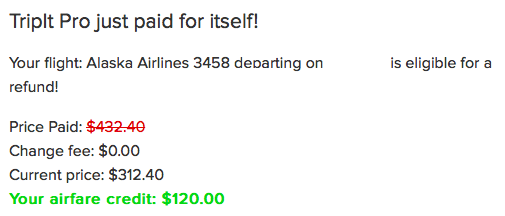
A credit for a decrease in fare can be made at any time before departure for either carrier. For Southwest, the same rule applies to an outright cancellation. Alaska is a little more tough and will let all customers cancel any ticket up to 60 days before departure, but this deadline is extended to the day of departure if you have MVP Gold or MVP Gold 75K status.
Deals We Like provided a very detailed walkthrough for requesting this credit when a fare drops on Southwest Airlines. I think it’s a little cumbersome because Southwest’s process is designed for a general change to your itinerary rather than re-pricing the same itinerary. In this post, I’ll walk you through the process on Alaska Airlines, which is specifically intended for re-pricing. Policies for other carriers are summarized at the end.
After I got my email alert from TripIt, I logged on to my Alaska account to find my reservation and clicked on the link for “Low Price Guarantee.”
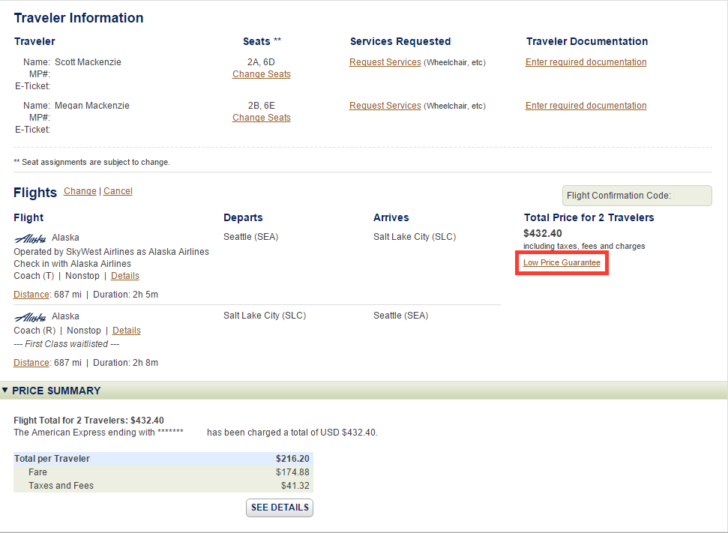
This brings you to a general page describing two options: requesting credit for a lower fare found elsewhere within 24 hours or for a lower fare found on AlaskaAir.com at any time. Click on the “Claim” button to continue.
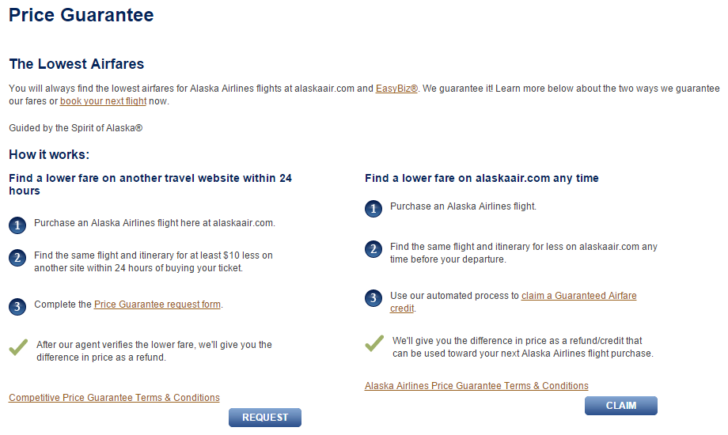
There are some Terms & Conditions for the latter, including that “you must be holding a fully unused ticket for flights operated by Alaska Airlines, Horizon Air, Penair between Anchorage and Dutch Harbor, and SkyWest Flight Series 3440-3499” and that it can’t include flights operated by any other carrier. If you used a Alaska Airlines companion fare to book your tickets, you’re still eligible.
I was asked to type in my name and confirmation number again, so make sure you have those handy. TripIt included it in my email, and it was a few pages back when you were viewing your reservation details. No other work was required beyond this. Alaska Airlines did it’s own search for the same flights on the same dates and returned a page showing the correct difference in fare. (Note: there was actually a lower price available due to a coupon code available on Monday, but I wasn’t able to claim that during this process. It was only 5%, so I won’t argue.)
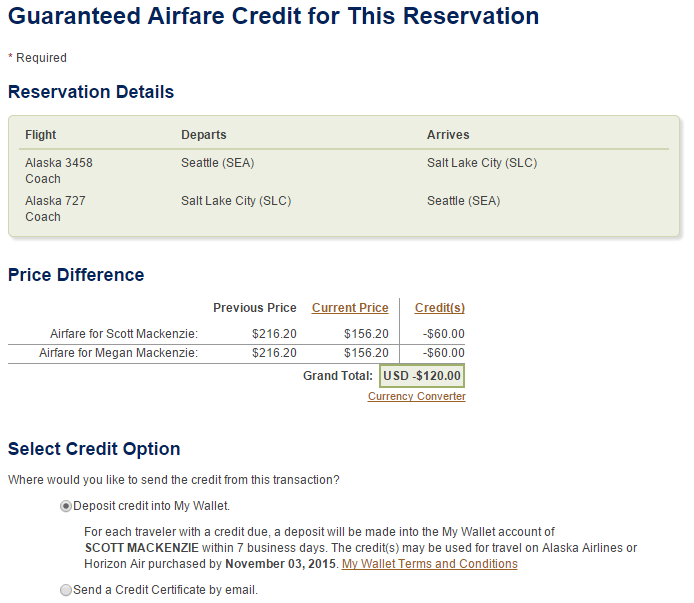
“My Wallet” is Alaska’s term for an online credit bank that makes it easy to track and apply credits to future flights. You don’t have to remember any certificate numbers, which I often lose or even forget I ever had. Though Megan was flying with me, the credit for both our tickets went into the My Wallet for my own account. I had to accept the new fare rules (which were pretty much the same) and acknowledge that I would lose any upgrades previously confirmed or requested.

After that I got a new page with my confirmed flight details, just as if I had made a new booking. The confirmation number remained the same, but the new fare was listed underneath. A message at the top informed me I would receive the funds in My Wallet within seven days. In fact, they were available that evening to book a new trip.

The only step remaining was to request my upgrade again. I’m still several weeks away from taking this trip, so it hadn’t been confirmed. But like American Airlines, complimentary upgrades for those with elite status need to be manually requested either during the reservation process or at a later time (if, for example, you booked through a travel agent). My outbound on a regional prop plane has no first class cabin, but I did request my upgrade again for the return journey.
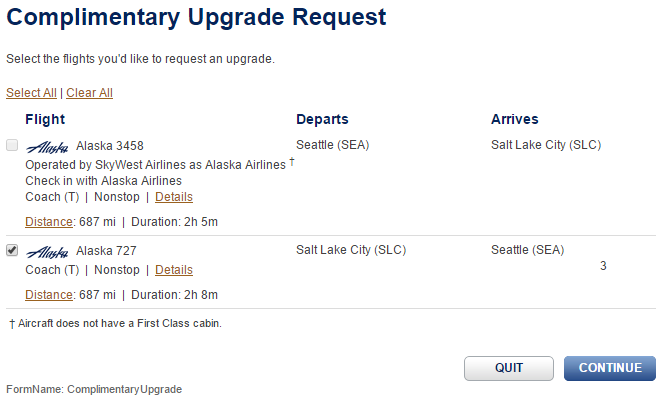
Upgrades are processed in the order they were added to the queue, so a change in fare could mean losing your place in line. However, I value the extra $120 more than a first class seat on a short, one-way flight.
Change Your Fare within 24 Hours for Free
Air travel can be cancelled and rebooked at a lower price even if it says “non-refundable.” For starters, you can generally cancel travel that begins or ends in the United States within 24 hours of booking. Why? Department of Transportation regulations require that airlines offer either a 24-hour hold or a 24-hour cancellation for free.
Most carriers opt for a cancellation policy, though American Airlines permits a hold instead. So if the price drops within 24 hours you cancel and rebook at the lower price without penalty. (Whereas I often say to book first and ask questions later when you see a great fare, this difference in policy means you would be smarter to put the ticket on hold and book later. You will be stuck with whatever you book on American.) The main catch is that travel must be booked more than 7 days before departure.
Most Carriers Put Lipstick on a Pig
Beyond 24 hours, you’re in a more complicated situation. Many carriers besides Southwest and Alaska still claim to offer a refund or credit if the price drops after you book. But in fact you’re just paying the change fee listed in the fare rules and applying the remaining credit to your new itinerary. That could be the same as your old itinerary, but this generally is not a requirement. US Airways is particularly guilty at trying to make this look like a benefit:
Our Lower Fare Guarantee allows a customer to receive any difference in fare, minus the change fee, in the form of an MCO through their travel agent if a lower fare is available and the following requirements are met:
There is no change to the itinerary (i.e. origin, destination, stopovers, flights, dates).
No portion of the itinerary has been flown.
The itinerary meets all rules of the lower fare at the time of reissue.
I’m not saying it isn’t generous to allow changes to a non-refundable fare. Even Spirit does it. But in my opinion, there’s not much of a “guarantee” if you have to pay a change fee that can range from $100-200 per person. Most fare changes are not large enough to result in a net gain — though international travel and especially premium cabin travel are more likely to benefit.
Truly Non-Refundable Fares
Delta introduced “Basic Economy” fares (E fare class) a couple years ago and has added many new restrictions since then, including removing the ability to upgrade even if you have elite status with Delta SkyMiles. But I think these fares stand out for another reason: they are not only non-refundable but also non-changeable.
I couldn’t think of any other major airline besides Delta that doesn’t allow changes for a fee, letting you keep the credit for a future flight. Please feel free to correct me, and I’ll update the post. But a non-changeable fare means that even this opportunity is unavailable. If you can’t or don’t want to fly on your original Basic Economy fare with Delta, you’re out of luck. That value is lost forever.
In Delta’s defense, you’ve also saved money up front. I can tell you from my experience that while I’ve taken advantage of fare change rules many times, I’ve never found myself in a situation where it was actually impossible for me to travel. My changes have always been optional and/or opportunistic. But keep this special restriction in mind because it goes against nearly all the other rules above (except the right to a 24 hour cancellation per DoT).
